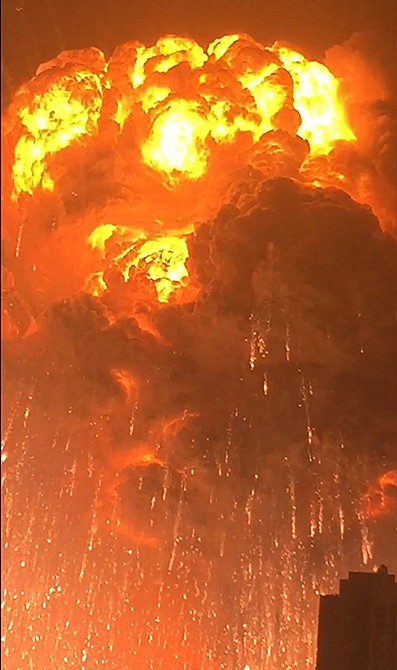TIANJIN, China (AP) - Rescuers pulled out a firefighter who was trapped for 32 hours after responding to a fire and huge explosions in the Chinese port city of Tianjin as authorities dealt Friday with a fire still smoldering amid potentially dangerous chemicals.
A rapid succession of explosions late Wednesday - one equal to 21 tons of TNT - killed at least 56 people, injured more than 720 and left several firefighters missing.
They were sparked by a fire at what authorities said were shipping containers containing hazardous material at a warehouse, and they struck a mostly industrial zone late at night - otherwise the death toll could have been much higher. But the warehouse was close enough to residences to appear out of compliance with safety regulations, raising questions about whether the facility had properly been authorized.
The toll included at least 21 firefighters among the more than 1,000 sent to the disaster. Firefighters initially responded to a fire at the warehouse and many of them apparently were killed by a series of explosions triggered 40 minutes after the fire was reported.
Zhou Ti, a 19-year-old firefighter, was pulled from the zone at about dawn Friday and taken to a hospital, where he was treated for face, chest and foot injuries, state broadcaster CCTV reported.
From his hospital bed, Zhou told CCTV the fire was spreading out of control. "I was knocked onto the ground at the first blast," recalled Zhou, his eyes closed. "I covered my head and don't know what happened after that."
Tianjin Fire Department head Zhou Tian said at a news conference Friday that the explosions occurred just as reinforcements had arrived on the scene and were just getting to work.
"There was no chance to escape, and that's why the casualties were so severe," the fire head said. "We're now doing all we can to rescue the missing." Zhou Tian and Zhou Ti are not related.
The rescue of the young firefighter was a bright moment in a day otherwise clouded by mistrust and unanswered questions. Local officials have been hard-pressed to explain why authorities permitted hazardous goods warehouses so close to residential complexes and critical infrastructure. They also have been publicly reticent about suspicions that firefighters may have sparked the explosions by spraying water on volatile chemicals.
Hazardous chemical warehouses must be at least 3,300 feet away from public buildings, highways, railways and industrial enterprises under regulations enacted by China's State Administration of Work Safety in 2001.
But Google Earth shows Ruihai's two hazmat warehouses are less than 550 yards from the S11 Haibin Expressway, and within 550 yards of a 1.1 million-square foot apartment complex built by China Vanke Co., one of China's largest developers.
Vanke said it acquired the land before Ruihai Logistics began loading toxic substances in its warehouses one block away. "The land was near normal logistics warehouses when we acquired it in April 2010," the company said in an emailed statement. "We were not aware they were later transformed into warehouses for hazardous material."
The housing development's windows were shattered and the side facing the explosions singed. The entire complex was evacuated and falls within a 1- to 2-mile zone around the blast site that has been cordoned off by police.
Local officials have publicly reassured a skeptical public that the blasts have not contaminated the air, but many residents weren't taking chances and could be seen Friday wearing air-filtering masks. "I don't usually wear a mask but I don't quite trust what the government says," Ma Wiehan said from behind her mask as she walked with her 6-month-old daughter. "I'm doing this for my child."
Questions about whether firefighters may have sparked the blasts have been circulating in the Chinese media. One report suggested water used by first responders may have come into contact with a chemical that explodes on contact with water, but an official also is quoted as saying the first wave of firefighters could not have sparked the blasts.
Many of the fire trucks seen at the site hours after the blasts use a kind of firefighting foam.
Authorities have not said what caused the explosions, saying only that they originated at the warehouse owned by Ruihai International Logistics. Its website says the company is authorized to handle chemicals ranging from flammable gases and liquids, including compressed natural gas and ethyl acetate, to chemicals that explode on contact with water, including sodium cyanide and calcium carbide.

